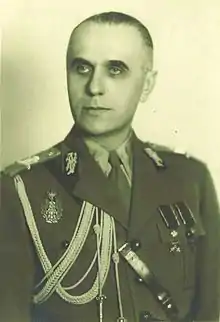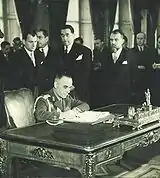Dumitru Dămăceanu
Dumitru Dămăceanu (17 July 1896 – 27 September 1978) was a Romanian army officer in World War II, later promoted to brigadier-general, who played a predominant role in the royal coup of August 23, 1944.[1]
Dumitru Dămăceanu | |
|---|---|
 General Dumitru Dămăceanu, 1945 | |
| Born | July 17, 1896 Cosmești, Galați County, Kingdom of Romania |
| Died | September 27, 1978 (aged 82) Bucharest, Socialist Republic of Romania |
| Allegiance | Romanian Army |
| Service/ | Infantry |
| Rank | brigadier general |
| Battles/wars | World War I–Romanian Campaign World War II |
| Awards | Order of Michael the Brave Order of the Star of Romania |
| Alma mater | Infantry Officer School in Sibiu Military Academy of Turin |
| Spouse(s) | Georgeta Stroescu |
Military and diplomatic career
Before World War II
Dămăceanu was born in the village of Cosmești, in Galați County, Romania. He attended the Costache Negruzzi Boarding High School of Iași, and then the Military School for Cavalry Officers in Târgoviște, graduating in 1916 with the rank of second lieutenant. He then fought in the Romanian campaign of World War I with the 6th Regiment Roșiori. After the war, he pursued his military education at Infantry Officer School in Sibiu (1923) and the Military Academy of Turin (1929).
In between the world wars, he was military attaché in Rome, Italy, director at the Voievodul Mihai School, and adjutant to King Carol II.[2]
During World War II
From 1941 to 1942 he was commanding officer of the 10th Roşiori Cavalry Regiment, fighting on the Eastern Front.[3] From 1942 to 1944 he was Chief of Staff of the Capital Military Command.
August 23, 1944 coup d'etat
Colonel Dămăceanu participated in the August 23, 1944 coup d'etat led by King Michael against the government of Marshal Ion Antonescu. He organized and coordinated the military actions and resistance in Bucharest. By the end of August 1944, he travelled to Moscow with a Romanian delegation; they were received by Soviet Foreign Minister Vyacheslav Molotov on August 30 or 31.[4] On September 12, 1944, General Dămăceanu was one of the plenipotentiary signatories of the Armistice Agreement between Romania and the Soviet Union (the other signatories were Lucrețiu Pătrășcanu, Ghiţă Popp, and Barbu Ştirbey on the Romanian side, and Rodion Malinovsky on the Soviet side).
Paris Peace Conference

In 1946, he was a member of the Gheorghe Tătărescu-led Romanian delegation to the Paris WW II Peace Conference. The Peace Treaty with Romania was signed in Paris on February 10, 1947, in the Salon de l'Horloge of the Ministère des Affaires Étrangères. On the Romanian side, the four signatories were Gheorghe Tătărescu (Council Vice-President), Lucrețiu Pătrășcanu (Minister of Justice), Ştefan Voitec (Minister of National Education), and Dămăceanu (Under-Secretary – Ministry of War). Other signatories included James F. Byrnes (US Secretary of State, for the United States), Vyacheslav Molotov (Foreign Affairs Minister, for the Soviet Union), and Ernest Bevin (Foreign Affairs Secretary, for the United Kingdom).[5]
1944–1947
By then, Dămăceanu had been promoted from colonel general to army general.[1]
From August 23, 1944, to December 30, 1947, he was Under-Secretary of State at the Ministry of Interior, Council of Ministers, Ministry of War-Land Forces.
Persecution
After King Michael's forced abdication and the complete Communist takeover, Dămăceanu was removed from the army. During the early 1950s he was degraded, arrested, tried and sentenced to serve time in prison.
Rehabilitation
After being released, during the 1960s, he was rehabilitated, receiving back his military rank – as a reserve officer. In 1974 he was promoted from the rank of colonel general to that of army general by presidential decree.[6]
Private life
In 1932 he married Georgeta Stroescu (born October 1912, died March 1996), and they had a daughter, Gabriela Romana Dămăceanu, born in May 1938 in Rome, Italy, while he was a military attaché.
Notes
- Woller, p. 112
- Secasiu
- Cristoiu
- Micu
- Dimăncescu
- Decret prezidenţial nr. 151/19 August 1974
References
- (in Romanian) Ion Cristoiu, "Istoria ca telenovelă – Deşănţata culme a propagandei", in Jurnalul Naţional, May 14, 2006.
- (in Romanian) Andreea Sminchise, "Centenarii României – 'Pacepa mi-a distrus băiatul...'", in Jurnalul Naţional, March 27, 2007.
- (in Romanian) Cornel Micu, "Armata Roşie ocupă Bucureştiul", in Jurnalul Naţional, October 26, 2005.
- (in Romanian) "Tristeţea omuleţului lui Gopo", in Săptămâna Financiară, June 20, 2005
- (in Romanian) "Generalul Aurel Aldea: 'Acesta este adevărul'-Document din arhivele Securităţii", from an article in Revista 22, by Claudiu Secasiu
- "Paris-WWII Peace Conference-1946: Settling Romania's Western Frontiers", notes prepared by Dan Dimăncescu from original files and records of D. Dem Dimăncescu, member of the Romanian Delegation at the Paris Peace Conference, available at the Honorary Consulate of Romania in Boston
- Rudolf Woller, "Warsaw Pact Reserve Systems: A White Paper", Bernard & Graefe, Munich, 1978. ISBN 3-7637-5205-6
External links
- "Generals from Romania: Dămăceanu, Dumitru". generals.dk.
- "Dimitri D. Dimăncescu, 1896-1984", at the Honorary Consulate of Romania in Boston, has a photograph of Dumitru Dămăceanu at the Paris Peace Conference in 1946
- (in Romanian) Cristina Diac and Florin Mihai, "1939-1944: 23 august, Cronica unui dezastru", in Jurnalul Naţional, August 23, 2006.